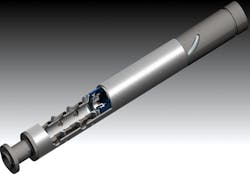Offshore staff
HOUSTON – Baker Hughes has released the CENtrilift PASS slimline ESP (electric submersible pump) system, which is designed to help operators optimize production and reserve recovery while lowering lifting costs in small-diameter wellbores or wells with restricted space due to casing patches or complex completion designs.
The oilfield services provider claims that it is the only small-diameter ESP system capable of operating at flow rates down to 50 b/d and that it includes a comprehensive suite of slimline gas-management technology. Although small-diameter wells are typically onshore, this system can be used in offshore applications where the completion design limits the amount of space available for the ESP system.
The new ESP system incorporates a Baker Hughes’ FLEXPumpER extended-range pump, engineered using computational fluid dynamic modeling software to provide the industry’s widest operating range for a 3.38-in. pump. The FLEXPumpER pump operates at flow rates from 2,500 to 50 b/d, mitigating the need to change out pumping systems as production rates decline. The pump’s optimized flow path also improves ESP system reliability by preventing solids build-up and abrasive wear in the pump.
The ESP system manages gas entrained in the production stream or gas slugs that break out of the reservoir. It combines natural and mechanical separation in a single design to minimize the amount of gas entering the pump, regardless of wellbore orientation.
When the ESP is deployed in a horizontal or deviated orientation, gravity cups shift to block the pump inlet ports on the high side of the intake where the gas accumulates, preventing the gas from entering the pump and venting it into the annulus.
When the ESP is installed in a vertical orientation, the production stream bypasses the gravity cups and mechanical vortex gas separation technology diverts gas away from the pump and into the annulus. For applications that only require mechanical gas separation, the CENtrilift PASS system includes a vortex gas separator. Unlike rotary gas separators, the company claims the vortex design is more efficient and more effective at separating gas from the fluid before it can enter the pump.
Any gas that does enter the pump is effectively handled by combining a GI gas insurance boost pump and a FLEXPumpER pump. Both pump designs are engineered to optimize performance in the presence of gas. When the two pump technologies are deployed together, the system can handle more than 60% gas volume fractions through the pump, Baker Hughes said.
The new ESP system also extends the pressure rating of the pump to 5,800 psi, allowing the ESP to be installed deeper in the well―closer to the producing zone―for greater reservoir pressure draw down and higher recovery rates. Enhancements to the 3.38-in. series motor design improve the mechanical and electrical strength of the motor by 30%, while reducing the angle of the motor-to-cable connection to mitigate potential damage during installation in smaller-diameter wellbores.
Ryan Moore, vice president, Artificial Lift Systems, said: “The CENtrilift PASS slimline ESP system gives operators who are drilling smaller-diameter wells to drive down drilling costs or to improve wellbore stability a full range of options to maximize production at the lowest possible lifting costs―even in challenging downhole conditions.
“The technology also expands the options for wells where complex completion schemes limit space availability for the artificial lift system, as well as in mature wells where casing patches restrict space in the wellbore. Without this slimline technology, operators would have to settle for less effective artificial lift methods.”
10/28/2016



